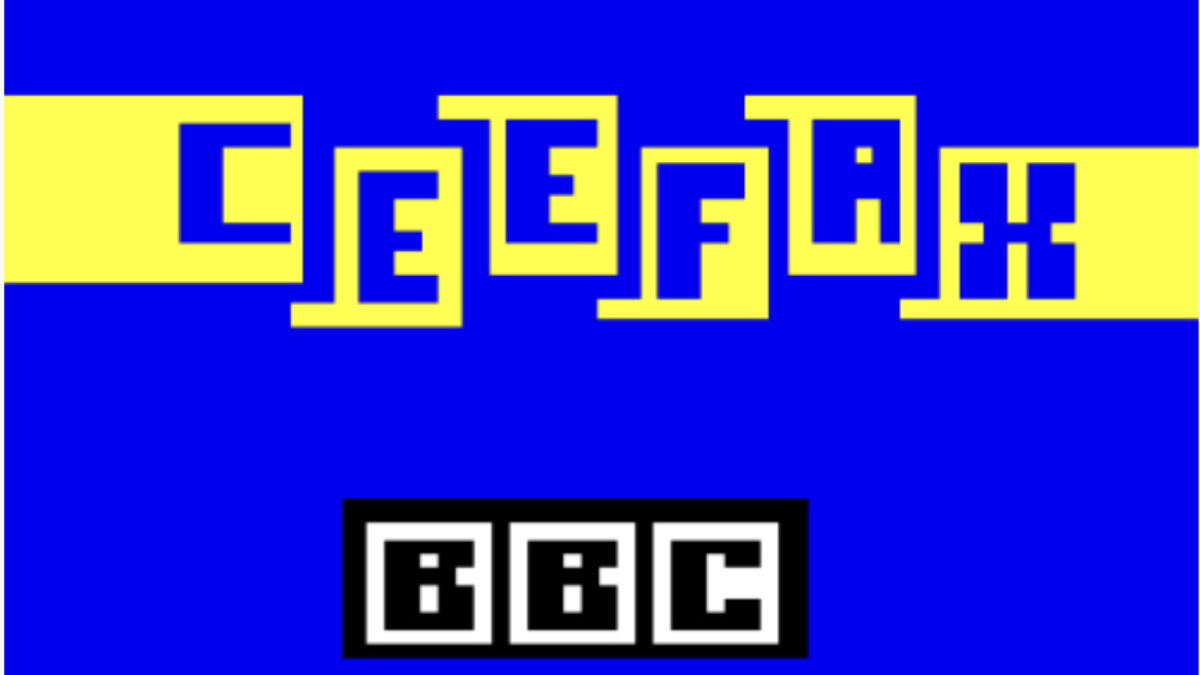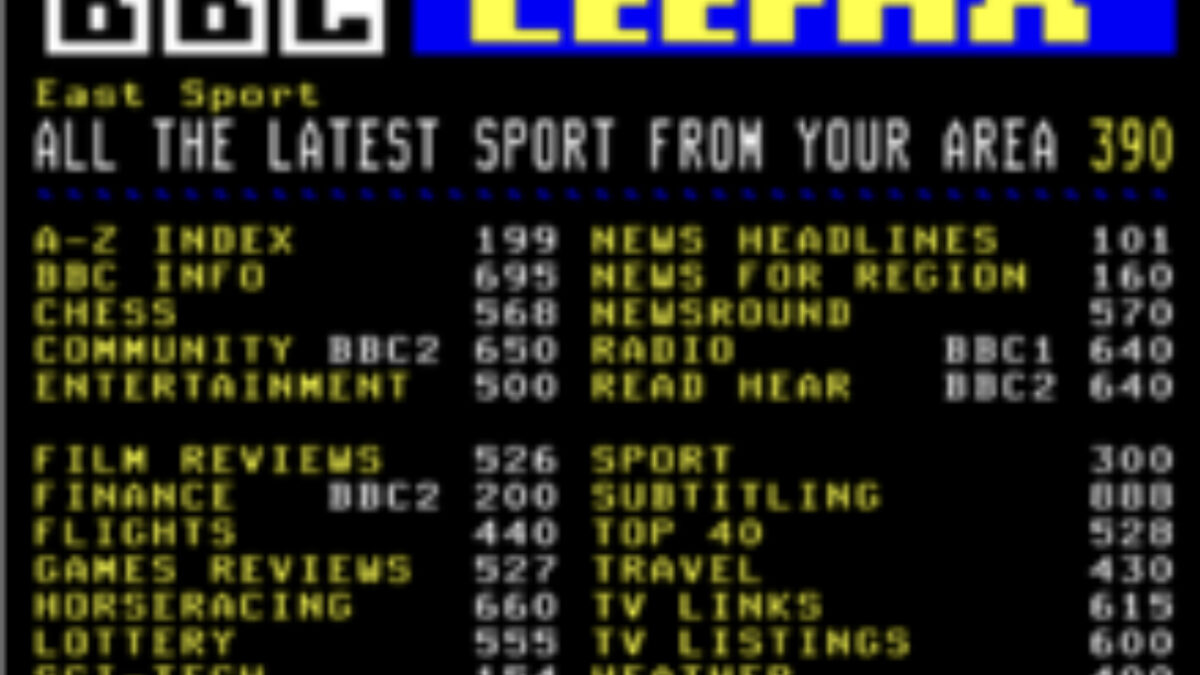History of Computing: Ceefax

History of Computing: Ceefax
By Fay Capstick
Ceefax as a service stopped broadcasting in 2012. Many of us have memories of using it to look up news and sports scores in near real time before the internet existed. This week, as part of our history of computing series, we will be looking at the history and legacy of the Ceefax, along with the wider teletext service and why their appeal still exists.
How did Ceefax start?
Ceefax was the first teletext service to be launched in the world. Teletext means literally a service that displayed text and pixelated graphics on a television screen. The data is hidden in the broadcast signal. This was displayed in pages that are given page numbers and the viewer could navigate by typing in the page number that they wanted to jump to using their remote. The teletext service was non-interactive, you could view pages but not upload any content.
The UK, regularly at the forefront of technological inventions in the twentieth century, was where teletext was created in 1970 by Philips Laboratories. The BBC launched its Ceefax service in 1974. Other systems were then introduced by other broadcasters in the UK and around the world.
By the 1980s most television sets that were sold came equipped with a teletext decoder. Teletext was also provided as an option via a plug-in circuit board. On smaller televisions teletext was usually only an option.
What information did it contain?
Most importantly the advent of a teletext system was the start of subtitles on televisions - they were transmitted using the system. This was life changing to deaf or hard of hearing viewers, as it increased their access to programmes.
The types of pages that could be accessed included news, sport and television scheduling information. The initial BBC offering on their Ceefax system in 1974 was 30 pages. By the mid-1980s Ceefax was broadcasting several hundred pages per broadcast television channel. For Ceefax this would have been BBC one and BBC two. Ultimately there were over 2,000 pages on Ceefax alone.
How did you view the content?
Content selected was displayed as blocky colour text on your television screen. To access different pages you typed the three digit page number required into your TV remote. The wait for your page to come up would be a few seconds.
Bizarrely, when there was a lack of broadcast programming, channels literally broadcast teletext pages instead. Starting in 1983, the BBC showed Ceefax pages every morning for 30 minutes before their breakfast programme. They called it Ceefax AM. Even more shockingly for those of us who are used to hundreds of channels, until September 1986, BBC Two would regularly show Pages from Ceefax from 9am all the way until 5.30pm when scheduled programming would start. Pages from Ceefax lasted on BBC One until 1997 and on BBC Two until 2012 (fun fact: the BBC website launched in 1997). It really is hard to comprehend such a world now.

How was Ceefax ground breaking?
By providing information that could be viewed and navigated on a television screen, the public would have been introduced to the idea of the internet and the accessing of information on a screen.
By the mid 1990s Ceefax was being viewed by 22 million people a week. This made it the most used news provider in the UK.
Before the internet and 24 hour news channels, it was often the case that breaking news would first be seen via a Ceefax broadcast. It was the internet before we knew what the internet was.
How did it end?
Ceefax and other European services were the most popular services in the world. Most comparable systems elsewhere in the world were closed by the early 1990s.
Ceefax and other European teletext services existed until the 2000s. Their demise was due to the increasing access the wider population had to the internet in their homes and due to digital tv broadcasts.
The BBC ended its Ceefax broadcasts in October 2012 when the UK switched to a fully digital television service. The BBC’s Red Button service had some content, including text news, but this too has been a reduced service since 2021. Channel 4 and ITV closed their teletext service in 2009.
It’s back, sort of..
Many television broadcasters continue to have a teletext offering via the broadcast signal on digital television, meaning more advanced systems can be offered. Others have teletext apps and web services.
Teefax is a similar service to Ceefax and runs on the Raspberry Pi computer. It has 12 pages of updated news and was introduced in 2016.
There is also a teletext equivalent service running on the internet by an enthusiast, Nathan Dane, who is barely old enough to remember Ceefax. You can access it here: https://www.nathanmediaservices.co.uk/teletext-viewer/. It is pulling data live off of news sources, so everything is up to date, and it uses a remote on screen to punch in the numbers. You then wait for it to scroll to your page. It’s still 101 for headlines. It is decidedly strange seeing modern headlines about Ukraine and recession in the instantly recognisable Ceefax form. it is also reassuringly simple and streamlined and free of pop up ads and cookie requests.
Why is it so fascinating now?
With the constant blur of social media and hundreds of television channels, Ceefax brings a sense of calm and nostalgia, both to those who remember it and those who are new to the concept. It also was wonderfully simple to use and view.
Conclusion
Ceefax also feels like the start of something similar to the internet, a proto-internet, with the ability to call up information (albeit limited) on demand. Facts were at our finger tips live (or nearly live) for the first time. It really was a huge technological achievement and one that brought a real difference into people lives.
Final thoughts
At Parker Shaw we have been at the forefront of the sector we serve, IT & Digital Recruitment and Consulting, for over 30 years. We can advise you on all your hiring needs. If you are looking for your next job in the IT sector please check our Jobs Board for our current live vacancies at https://parkershaw.co.uk/jobs-board.
